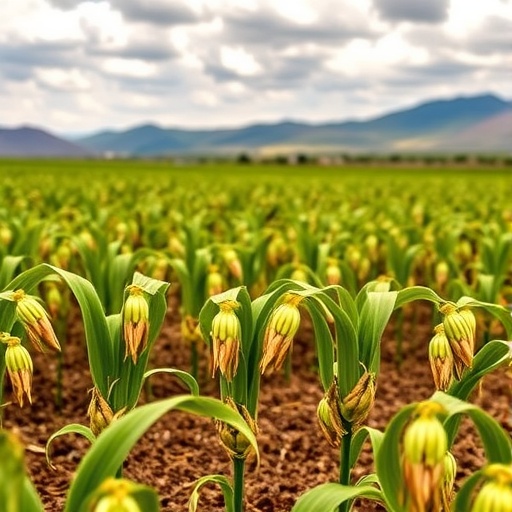Southern Africa is on the precipice of a potential crisis in food security, and recent studies underline the gravity of the situation. For the past two decades, cropland productivity across the region has notably stagnated, a stark contrast to the optimistic narratives often portrayed by official crop statistics. This paradox raises critical questions about the current methodologies utilized in agricultural assessments and their implications for agricultural policies in Southern Africa. While South Africa appears as an outlier in this troubling trend, the broader context indicates a worrying pattern that demands urgent attention.
The stagnation of cropland productivity in Southern Africa is not a phenomenon easily explained by prevailing climate trends—most notably, the increase in rainfall and comparatively lesser warming than what climate model projections have forecasted. Such favorable climatic conditions should ostensibly promote higher yields; however, the economic and agricultural realities tell a different story. The discrepancy between satellite measures and reported crop yields necessitates a closer examination of underlying factors, including potential socio-economic barriers and inefficiencies in agricultural practices.
The reliance on satellite data illustrates a significant evolution in assessing agricultural productivity. Utilizing satellite measures provides a more accurate reflection of land usage and productivity compared to traditional reporting methods, which can often be colored by local interpretations and bureaucratic tendencies to inflate statistics. This technological approach is crucial, as it offers a bird’s-eye view of agricultural health, capable of revealing insights that would otherwise remain hidden in ground-level assessments.
Despite the apparent abundance of rainfall in recent years—historically a lifeline for agricultural productivity—the effectiveness of this water resource is compromised by systemic issues in the region. Farmers in Southern Africa often confront significant barriers, including access to essential resources such as fertilizers, improved seeds, and modern agricultural techniques. These obstacles contribute to what can be termed the “productivity paradox,” wherein favorable climatic conditions do not translate into improved crop yields.
Furthermore, climate variability poses an ongoing threat to the agricultural landscape of Southern Africa. While some areas may experience increased rainfall, others face drought or unpredictable weather patterns that disrupt farming practices. This variability forces farmers to adopt what can best be described as reactive strategies, rather than proactive ones that would enhance crop resilience and productivity. The integration of advanced agricultural techniques and technologies, coupled with responsive policy frameworks, could mitigate some of these risks, yet such shifts appear to remain out of reach for many.
To foster a more favorable agricultural environment, investment in research and development is paramount. Innovative agricultural practices that harness new technologies, such as precision farming and climate-smart agriculture, are vital. These methods not only enhance productivity but also contribute to sustainability by conserving resources and reducing the environmental impact of farming. However, the implementation of such practices is often hindered by a lack of financial resources, knowledge, and technical support, further perpetuating the cycle of stagnation.
The role of governance and policy cannot be understated in addressing these challenges. Effective agricultural policies should aim to create an enabling environment for farmers by promoting investments in infrastructure, education, and access to markets. Government initiatives that support smallholder farmers—who constitute a significant portion of the agricultural workforce—are essential in facilitating the transition towards improved productivity and food security.
Regional collaborations and partnerships can further enhance efforts to combat stagnation in agricultural productivity. By sharing knowledge, resources, and technologies, nations within Southern Africa can collectively tackle the issues facing their agricultural sectors. Furthermore, engaging with international organizations and stakeholders can unlock additional financial and technical support necessary for implementing innovative solutions.
Moving beyond mere statistical reports is vital for accurately addressing the agricultural crises facing Southern Africa. A multifaceted approach is required, combining advanced data analytics, enhanced agricultural techniques, and supportive policy measures. As projections indicate potential declines in agroclimatic conditions, proactive steps must be taken now to avert an escalation of food insecurity in the future.
Moreover, the socioeconomic context surrounding agriculture in Southern Africa must be examined. Structural inequalities, such as land ownership and access to markets, significantly affect farmers’ productivity and income. Policies aiming to rectify these disparities—such as land reform and improved access to agricultural financing—are essential components for fostering a more equitable agricultural landscape.
In conclusion, the stagnation of agricultural productivity in Southern Africa is a complex issue that entails a multifactorial approach to address effectively. Relying solely on favorable climate conditions will not suffice; a synergistic combination of advanced technologies, comprehensive policies, and sustainable practices is imperative. The region stands at a crossroads, where immediate and concerted efforts can either lead to a resurgence in agricultural productivity or exacerbate the existing crisis in food security.
The challenges are vast, but the opportunities for transformation are equally significant. As Southern Africa grapples with these critical agricultural dynamics, the focus must shift from mere data interpretation to actionable strategies that prioritize sustainability and resilience. Ultimately, the fate of millions who depend on agriculture for their livelihoods hinges on the decisions made in the short term—a reality that necessitates urgent action for the betterment of the region’s agricultural future.
Subject of Research: Food Security and Agricultural Productivity in Southern Africa
Article Title: Crop productivity in southern Africa is stagnant despite moderate climate trends.
Article References:
Lobell, D.B., Lee, R.J. Crop productivity in southern Africa is stagnant despite moderate climate trends. Nat Food 6, 762–765 (2025). https://doi.org/10.1038/s43016-025-01203-1
Image Credits: AI Generated
DOI: https://doi.org/10.1038/s43016-025-01203-1
Keywords: Food Security, Agricultural Productivity, Southern Africa, Satellite Data, Climate Trends, Sustainable Agriculture, Socioeconomic Challenges, Policy, Innovation.
Tags: agricultural productivity assessment methodschallenges in Southern Africa agricultureclimate trends impact on agriculturediscrepancies in crop yield reportingfood security crisis Southern Africainefficiencies in agricultural practicesrainfall patterns and crop productivitysatellite data in crop yield measurementsocio-economic barriers in farmingSouth Africa agricultural outlierSouthern Africa crop yields stagnationurgent need for agricultural policy reform





